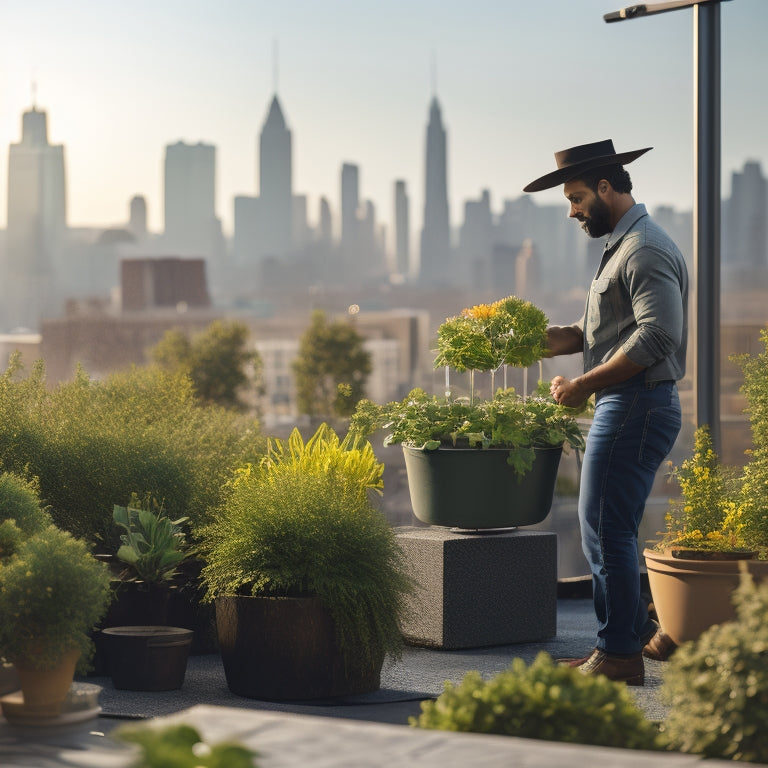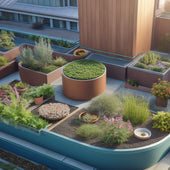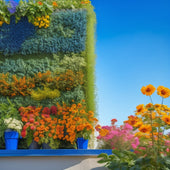
7 Best Spring Fertilization Tips for Rooftop Gardens
Share
To enhance your rooftop garden's fertilization strategy this spring, start by conducting a soil test to determine nutrient levels and pH, then select organic fertilizers that address specific deficiencies. Balance nitrogen and phosphorus levels to support leaf growth and root development. Fertilize after pruning, when soil temperatures are ideal, and consider wind direction to minimize drift. Implement efficient watering techniques, like drip irrigation, and monitor plant responses to adjust fertilizer applications. By following these tips, you'll be well on your way to promoting healthy plant growth, vibrant flowering, and maximum yield in your rooftop garden, but there's more to learn to guarantee a thriving oasis.
Key Takeaways
• Conduct a soil test to determine nutrient levels and pH before fertilizing to ensure optimal nutrient availability for rooftop plants.
• Apply slow-release organic fertilizers in the spring to provide a consistent nutrient supply throughout the growing season.
• Balance nitrogen and phosphorus levels to support healthy leaf growth, root development, and flowering in rooftop garden plants.
• Fertilize after pruning to support new growth, and remove dead plant material to prevent decay and promote healthy soil microbiome.
• Schedule spring fertilization during optimal growth periods and combine it with mulching to retain moisture and suppress weeds in rooftop gardens.
Start With Soil Testing
Before you begin fertilizing your rooftop garden, have you considered the current state of your soil's nutrient levels, pH, and overall composition? These factors greatly impact the effectiveness of your fertilization efforts.
It's crucial to understand that your soil's pH, which can range from acidic to alkaline, affects the availability of nutrients for your plants. For instance, a pH that's too high or too low can limit nutrient uptake, leading to poor plant growth.
To gain a deeper understanding of your soil's nutrient composition, consider conducting a soil test. This will provide you with a detailed report of your soil's macronutrient and micronutrient levels, as well as its pH.
With this information, you can tailor your fertilization strategy to address any deficiencies or imbalances. By doing so, you'll be able to create a favorable environment for your plants to thrive.
Choose Organic Fertilizers Wisely
When selecting organic fertilizers for your rooftop garden, consider the specific nutrient deficiencies or imbalances revealed by your soil test, and opt for products that address those needs. This guarantees you're providing your plants with exactly what they require, rather than relying on a one-size-fits-all approach.
Here are some key considerations when choosing organic fertilizers:
-
Slow-release vs. quick-release: Select organic fertilizers with slow-release nutrient profiles to provide sustained nourishment to your plants over an extended period.
-
Organic fertilizer types: Look for products based on natural ingredients like bone meal, fish bone meal, or alfalfa meal, which release nutrients as they break down.
-
Nutrient release: Opt for fertilizers with a balanced nutrient release pattern, ensuring your plants receive the necessary nutrients at the right time.
- Soil microbiome support: Choose organic fertilizers that promote a healthy soil microbiome, as this will enhance nutrient availability and uptake in your rooftop garden.
Balance Nitrogen and Phosphorus
In your rooftop garden, maintaining a delicate balance between nitrogen and phosphorus is essential, as these two macronutrients play critical roles in plant growth and development.
Nitrogen promotes leaf growth, green color, and overall plant vigor, while phosphorus supports root development, flower and fruit production, and resistance to disease. You'll want to guarantee you're providing adequate amounts of both, as an imbalance can lead to stunted growth or weakened plants.
When selecting fertilizers, consider nitrogen sources such as fish emulsion, blood meal, and composted manure. These organic options release nitrogen slowly, reducing the risk of over-fertilization.
For phosphorus, look for types like bone meal, rock phosphate, and diammonium phosphate. These phosphorus types promote strong root systems and support overall plant health.
Be mindful of your plants' specific needs, as some may require more nitrogen or phosphorus than others. By striking the right balance, you'll create a thriving rooftop garden that's well-equipped to handle the challenges of spring.
Fertilize After Pruning Cycle
As you prepare your rooftop garden for spring fertilization, it's crucial to fertilize after your pruning cycle.
You'll want to do this during the pruning prep time, when you're removing dead plant material and shaping your plants for the new growing season.
Pruning Prep Time
You'll want to time your fertilization cycle to coincide with the pruning cycle, since pruning stimulates new growth and fertilizing afterwards helps support this new development. This is especially important for rooftop gardens, where soil quality and nutrient availability can be limited. By pruning before fertilizing, you'll guarantee that your plants are receptive to the nutrients they need to thrive.
Before you start pruning, make sure you have the right tools and techniques. Here are a few tips to get you started:
-
Choose the right pruning tools: Invest in high-quality, sharp pruning shears and loppers to make clean cuts and prevent damaging your plants.
-
Develop a pruning plan: Identify which plants need pruning, and prioritize those that are overgrown or damaged.
-
Use proper pruning techniques: Cut branches at a 45-degree angle, and remove any weak or dead growth to promote healthy development.
- Prune at the right time: Prune your plants when they're dormant, or during the active growing season, depending on the species and its needs.
Remove Dead Plant Material
Dead plant material, like wilted leaves and brittle stems, must be removed to prevent decay and create a clean slate for fertilization.
You'll want to dispose of this dead material properly to maintain a healthy environment for your rooftop garden. Improper dead material disposal can lead to the spread of disease and pests, ultimately compromising plant health.
Take the time to carefully inspect your plants, removing any dead or dying parts. This won't only prevent decay but also encourage new growth and promote healthy development.
As you remove dead plant material, take note of any signs of disease or pests. This is a vital step in maintaining a healthy rooftop garden, as it allows you to address any issues before they spread.
By removing dead material and addressing potential problems, you'll be able to create an ideal environment for fertilization. This, in turn, will enable your plants to thrive and reach their full potential.
Consider Weather and Climate
Your rooftop garden's microclimate is influenced by its exposure to sunlight, wind direction, and temperature fluctuations, making it crucial to take into account these weather and climate factors when planning your spring fertilization strategy.
As you prepare for the new growing season, don't overlook the impact of seasonal changes on your plants' nutrient needs.
To guarantee your rooftop garden thrives, consider the following factors when fertilizing:
-
Temperature fluctuations: Fertilize when soil temperatures are between 55°F and 65°F, ideal for root growth and nutrient uptake.
-
Wind direction: If your rooftop garden receives strong winds, use a fertilizer that's resistant to wind erosion or apply it in a way that minimizes drift.
-
Sunlight exposure: Fertilize plants in areas with full sun differently than those in partial shade, as they've varying nutrient requirements.
- Moisture levels: Adjust your fertilizer application based on the soil's moisture content, as excess water can lead to nutrient leaching.
Water Efficiently After Fertilizing
After fertilizing, it's crucial to water efficiently to prevent nutrient leaching and maximize absorption, especially in rooftop gardens where water conservation is critical. You'll want to guarantee that the fertilizer is fully absorbed by the plants, and excess water isn't wasted.
To achieve this, consider installing a drip irrigation system, which delivers water directly to the roots, reducing evaporation and runoff. This targeted approach also encourages healthy root growth and minimizes the risk of overwatering.
Additionally, you can harvest rainwater to supplement your irrigation needs. This not only reduces your water bill but also decreases the demand on municipal water supplies. By collecting and storing rainwater, you'll have a readily available source of water for your rooftop garden during dry spells.
When watering, avoid frequent shallow watering, which can lead to weak root systems. Instead, water deeply and infrequently to encourage deep root growth and make your plants more resilient to drought.
Monitor Plant Response Closely
Within a week or two of fertilizing, closely observe your plants for signs of response, such as changes in leaf color, growth rate, or flowering patterns, to gauge the effectiveness of your fertilizer application. This is essential in understanding how your plants are responding to the nutrients and making adjustments accordingly.
Here are some key things to look out for:
-
Increased plant growth: Are your plants growing faster, stronger, or more vigorously? This could be a sign that the fertilizer is providing the necessary nutrients for ideal growth.
-
Changes in leaf color: Are the leaves a deeper green or more vibrant? This could indicate improved nutrient absorption and healthier plant cells.
-
Enhanced flowering: Are your plants producing more flowers or blooming earlier than expected? This could be a sign that the fertilizer is promoting healthy plant development.
- Reduced pest or disease issues: Are your plants less prone to pests or diseases? This could indicate that the fertilizer is helping to strengthen your plants' natural defenses.
Frequently Asked Questions
Can I Fertilize My Rooftop Garden in the Summer Instead of Spring?
You can fertilize your rooftop garden in the summer, but it's not ideal; summer fertilization can cause excessive growth, making plants more susceptible to heat stress, so adjust your rooftop plant care strategy accordingly.
How Often Should I Fertilize My Rooftop Garden During the Growing Season?
"Imagine your rooftop garden as a hungry athlete, needing nourishment at the right intervals. You'll want to feed it with balanced fertilizer types every 4-6 weeks during the growing season, fine-tuning the schedule based on plant growth and weather conditions."
Are There Any Fertilizers Specifically Designed for Rooftop Gardens?
You'll find fertilizers specifically designed for rooftop gardens, offering organic options that guarantee a precise nutrient balance, and you'll want to choose one that's formulated to address wind-borne nutrient loss and high-temperature stress.
Can I Use Compost From My Kitchen as Fertilizer for My Rooftop Garden?
You can ditch commercial fertilizers and harness the power of your kitchen scraps, as compost benefits your rooftop garden by providing nutrient-rich soil, improved drainage, and a reduced carbon footprint, all while controlling what goes into your garden.
Will Fertilizing My Rooftop Garden Attract More Pests and Insects?
When you fertilize your rooftop garden, you'll need to balance nutrient delivery with pest management; proper insect control measures, like introducing beneficial insects, will help mitigate unwanted visitors attracted to the nutrient-rich environment you're creating.
Related Posts
-

Irrigation System Design Ideas for Concrete Planters
As you design an irrigation system for your concrete planters, you'll need to balance drainage, moisture retention, a...
-

Irrigation System Design Ideas for Concrete Planters
As you design an irrigation system for your concrete planters, you'll need to balance drainage, moisture retention, a...
-

Irrigation System Design Ideas for Concrete Planters
As you design an irrigation system for your concrete planters, you'll need to balance drainage, moisture retention, a...
-

Irrigation System Design Ideas for Concrete Planters
As you design an irrigation system for your concrete planters, you'll need to balance drainage, moisture retention, a...
-

Irrigation System Design Ideas for Concrete Planters
As you design an irrigation system for your concrete planters, you'll need to balance drainage, moisture retention, a...
-

Irrigation System Design Ideas for Concrete Planters
As you design an irrigation system for your concrete planters, you'll need to balance drainage, moisture retention, a...
-

Irrigation System Design Ideas for Concrete Planters
As you design an irrigation system for your concrete planters, you'll need to balance drainage, moisture retention, a...
-

Irrigation System Design Ideas for Concrete Planters
As you design an irrigation system for your concrete planters, you'll need to balance drainage, moisture retention, a...
-

Irrigation System Design Ideas for Concrete Planters
As you design an irrigation system for your concrete planters, you'll need to balance drainage, moisture retention, a...
-

Irrigation System Design Ideas for Concrete Planters
As you design an irrigation system for your concrete planters, you'll need to balance drainage, moisture retention, a...
-

Irrigation System Design Ideas for Concrete Planters
As you design an irrigation system for your concrete planters, you'll need to balance drainage, moisture retention, a...
-

Irrigation System Design Ideas for Concrete Planters
As you design an irrigation system for your concrete planters, you'll need to balance drainage, moisture retention, a...
-

Irrigation System Design Ideas for Concrete Planters
As you design an irrigation system for your concrete planters, you'll need to balance drainage, moisture retention, a...
-

Irrigation System Design Ideas for Concrete Planters
As you design an irrigation system for your concrete planters, you'll need to balance drainage, moisture retention, a...
-

Irrigation System Design Ideas for Concrete Planters
As you design an irrigation system for your concrete planters, you'll need to balance drainage, moisture retention, a...
-

Irrigation System Design Ideas for Concrete Planters
As you design an irrigation system for your concrete planters, you'll need to balance drainage, moisture retention, a...
-

Irrigation System Design Ideas for Concrete Planters
As you design an irrigation system for your concrete planters, you'll need to balance drainage, moisture retention, a...
-

Irrigation System Design Ideas for Concrete Planters
As you design an irrigation system for your concrete planters, you'll need to balance drainage, moisture retention, a...
-

Irrigation System Design Ideas for Concrete Planters
As you design an irrigation system for your concrete planters, you'll need to balance drainage, moisture retention, a...
-

Irrigation System Design Ideas for Concrete Planters
As you design an irrigation system for your concrete planters, you'll need to balance drainage, moisture retention, a...
-

Irrigation System Design Ideas for Concrete Planters
As you design an irrigation system for your concrete planters, you'll need to balance drainage, moisture retention, a...
-

Irrigation System Design Ideas for Concrete Planters
As you design an irrigation system for your concrete planters, you'll need to balance drainage, moisture retention, a...
-

Irrigation System Design Ideas for Concrete Planters
As you design an irrigation system for your concrete planters, you'll need to balance drainage, moisture retention, a...
-

Irrigation System Design Ideas for Concrete Planters
As you design an irrigation system for your concrete planters, you'll need to balance drainage, moisture retention, a...
-

Irrigation System Design Ideas for Concrete Planters
As you design an irrigation system for your concrete planters, you'll need to balance drainage, moisture retention, a...
-

Irrigation System Design Ideas for Concrete Planters
As you design an irrigation system for your concrete planters, you'll need to balance drainage, moisture retention, a...
-

Irrigation System Design Ideas for Concrete Planters
As you design an irrigation system for your concrete planters, you'll need to balance drainage, moisture retention, a...
-

Irrigation System Design Ideas for Concrete Planters
As you design an irrigation system for your concrete planters, you'll need to balance drainage, moisture retention, a...
-

Irrigation System Design Ideas for Concrete Planters
As you design an irrigation system for your concrete planters, you'll need to balance drainage, moisture retention, a...
-

Irrigation System Design Ideas for Concrete Planters
As you design an irrigation system for your concrete planters, you'll need to balance drainage, moisture retention, a...
-

Irrigation System Design Ideas for Concrete Planters
As you design an irrigation system for your concrete planters, you'll need to balance drainage, moisture retention, a...
-

3 Best Roof Garden Drainage Solutions for Planters
When designing your roof garden, you'll want to implement a planter drainage system that guarantees water flows freel...
-

3 Best Roof Garden Drainage Solutions for Planters
When designing your roof garden, you'll want to implement a planter drainage system that guarantees water flows freel...
-

3 Best Roof Garden Drainage Solutions for Planters
When designing your roof garden, you'll want to implement a planter drainage system that guarantees water flows freel...
-

3 Best Roof Garden Drainage Solutions for Planters
When designing your roof garden, you'll want to implement a planter drainage system that guarantees water flows freel...
-

3 Best Roof Garden Drainage Solutions for Planters
When designing your roof garden, you'll want to implement a planter drainage system that guarantees water flows freel...
-

3 Best Roof Garden Drainage Solutions for Planters
When designing your roof garden, you'll want to implement a planter drainage system that guarantees water flows freel...
-

3 Best Roof Garden Drainage Solutions for Planters
When designing your roof garden, you'll want to implement a planter drainage system that guarantees water flows freel...
-

3 Best Roof Garden Drainage Solutions for Planters
When designing your roof garden, you'll want to implement a planter drainage system that guarantees water flows freel...
-

3 Best Roof Garden Drainage Solutions for Planters
When designing your roof garden, you'll want to implement a planter drainage system that guarantees water flows freel...
-

3 Best Roof Garden Drainage Solutions for Planters
When designing your roof garden, you'll want to implement a planter drainage system that guarantees water flows freel...
-

3 Best Roof Garden Drainage Solutions for Planters
When designing your roof garden, you'll want to implement a planter drainage system that guarantees water flows freel...
-

3 Best Roof Garden Drainage Solutions for Planters
When designing your roof garden, you'll want to implement a planter drainage system that guarantees water flows freel...
-

3 Best Roof Garden Drainage Solutions for Planters
When designing your roof garden, you'll want to implement a planter drainage system that guarantees water flows freel...
-

5 Tips for Thriving Vertical Vegetable Gardens
To thrive in vertical vegetable gardening, you'll want to choose a planter that meets the unique needs of your veggie...
-

5 Tips for Thriving Vertical Vegetable Gardens
To thrive in vertical vegetable gardening, you'll want to choose a planter that meets the unique needs of your veggie...
-

5 Tips for Thriving Vertical Vegetable Gardens
To thrive in vertical vegetable gardening, you'll want to choose a planter that meets the unique needs of your veggie...
-

5 Tips for Thriving Vertical Vegetable Gardens
To thrive in vertical vegetable gardening, you'll want to choose a planter that meets the unique needs of your veggie...
-

5 Tips for Thriving Vertical Vegetable Gardens
To thrive in vertical vegetable gardening, you'll want to choose a planter that meets the unique needs of your veggie...
-

5 Tips for Thriving Vertical Vegetable Gardens
To thrive in vertical vegetable gardening, you'll want to choose a planter that meets the unique needs of your veggie...
-

5 Tips for Thriving Vertical Vegetable Gardens
To thrive in vertical vegetable gardening, you'll want to choose a planter that meets the unique needs of your veggie...
-

5 Tips for Thriving Vertical Vegetable Gardens
To thrive in vertical vegetable gardening, you'll want to choose a planter that meets the unique needs of your veggie...
-

5 Tips for Thriving Vertical Vegetable Gardens
To thrive in vertical vegetable gardening, you'll want to choose a planter that meets the unique needs of your veggie...
-

5 Tips for Thriving Vertical Vegetable Gardens
To thrive in vertical vegetable gardening, you'll want to choose a planter that meets the unique needs of your veggie...
-

5 Tips for Thriving Vertical Vegetable Gardens
To thrive in vertical vegetable gardening, you'll want to choose a planter that meets the unique needs of your veggie...
-

5 Tips for Thriving Vertical Vegetable Gardens
To thrive in vertical vegetable gardening, you'll want to choose a planter that meets the unique needs of your veggie...
-

5 Tips for Thriving Vertical Vegetable Gardens
To thrive in vertical vegetable gardening, you'll want to choose a planter that meets the unique needs of your veggie...
-

5 Tips for Thriving Vertical Vegetable Gardens
To thrive in vertical vegetable gardening, you'll want to choose a planter that meets the unique needs of your veggie...
-

5 Tips for Thriving Vertical Vegetable Gardens
To thrive in vertical vegetable gardening, you'll want to choose a planter that meets the unique needs of your veggie...
-

5 Tips for Thriving Vertical Vegetable Gardens
To thrive in vertical vegetable gardening, you'll want to choose a planter that meets the unique needs of your veggie...
-

5 Tips for Thriving Vertical Vegetable Gardens
To thrive in vertical vegetable gardening, you'll want to choose a planter that meets the unique needs of your veggie...


